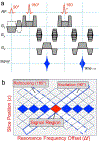2D multi-spectral imaging for fast MRI near metal
- PMID: 28444805
- PMCID: PMC8223256
- DOI: 10.1002/mrm.26724
2D multi-spectral imaging for fast MRI near metal
Abstract
Purpose: To develop a fast 2D method for MRI near metal with reduced B0 in-plane and through-slice artifacts.
Methods: Multi-spectral imaging (MSI) approaches reduce artifacts in MR images near metal, but require 3D imaging of multiple excited volumes regardless of imaging geometry or artifact severity. The proposed 2D MSI method rapidly excites a limited slice and spectral region using gradient reversal between excitation and refocusing pulses, then uses standard 2D imaging, with the process repeating to cover multiple spectral offsets that are combined as in other MSI techniques. 2D MSI was implemented in a spin-echo-train sequence and validated in phantoms and in vivo by comparing it with standard spin-echo imaging and existing MSI techniques.
Results: 2D MSI images for each spatial-spectral region follow isocontours of the dipole-like B0 field variation, and thus frequency variation, near metal devices. Artifact correction in phantoms and human subjects with metal is comparable to 3D MSI methods, and superior to standard spin-echo techniques. Scan times are reduced compared with 3D MSI methods in cases where a limited number of slices are needed, though signal-to-noise ratio is also reduced as expected.
Conclusion: 2D MSI offers a fast and flexible alternative to 3D MSI for artifact reduction near metal. Magn Reson Med 79:968-973, 2018. © 2017 International Society for Magnetic Resonance in Medicine.
Keywords: MAVRIC; SEMAC; artifact; metal; multi-spectral imaging.
© 2017 International Society for Magnetic Resonance in Medicine.
Figures





References
-
- Schenck JF. The role of magnetic susceptibility in magnetic resonance imaging: MRI magnetic compatibility of the first and second kinds. Med Phys 1996; 23:815–850. - PubMed
-
- Ladd ME, Erhart P, Debatin JF, Romanowski BJ, Boesiger P, McKinnon GC. Biopsy needle susceptibility artifacts. ”Magn Reson Med.” 1996; 36:646–651. - PubMed
-
- Koch K, Hargreaves B, Pauly K, Chen W, Gold G, King K. Magnetic resonance imaging near metal implants. Journal of Magnetic Resonance Imaging 2010; 32:773–787. - PubMed
-
- Koch KM, Lorbiecki JE, Hinks RS, King KF. A multispectral three-dimensional acquisition technique for imaging near metal implants. Magn Reson Med 2009; 61:381–390. - PubMed
Publication types
MeSH terms
Substances
Grants and funding
LinkOut - more resources
Full Text Sources
Other Literature Sources
Medical

